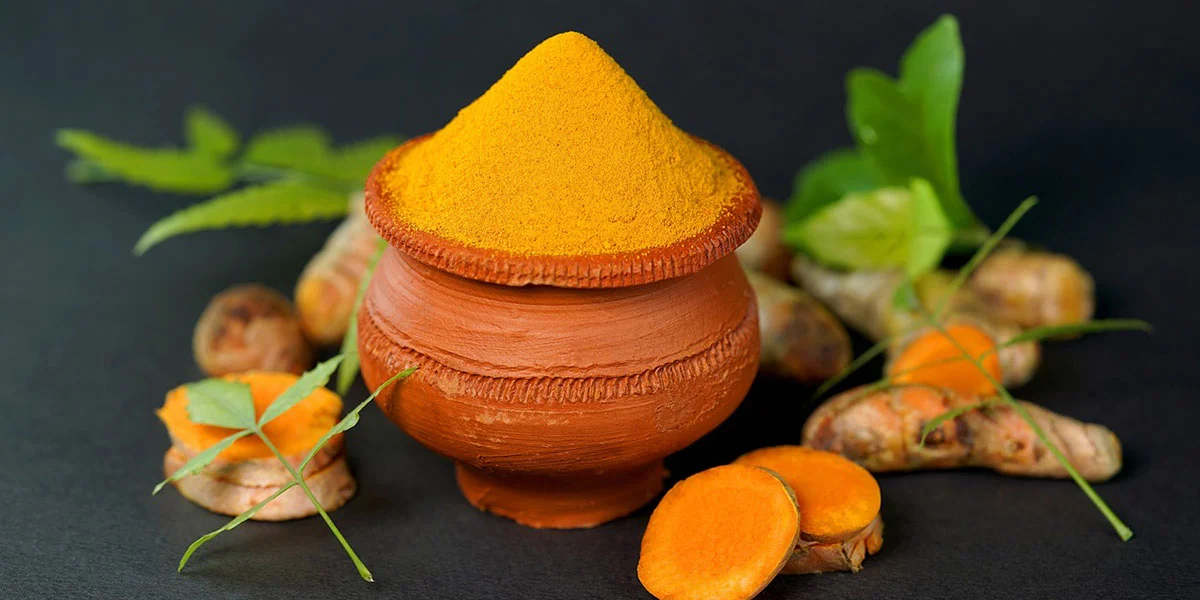Turmeric(Haldi) is a bright yellow spice that comes from the root of the turmeric plant (Curcuma longa). It is a flowering plant belonging to the ginger family (Zingiberaceae) and is native to the Indian subcontinent and Southeast Asia.
The spice has a long history of culinary and medicinal use in these regions.
To produce turmeric, the rhizomes (underground stems) of the turmeric plant are harvested, cleaned, boiled, dried, and then ground into a fine powder. The resulting powder is what we commonly know as turmeric spice.
Turmeric has a warm, bitter flavor and a distinct earthy aroma. It is widely used as a culinary spice, especially in South Asian and Middle Eastern cuisines. It is a key ingredient in many curry dishes, giving them their characteristic yellow color. Turmeric is also used to flavor various rice dishes, sauces, soups, and stews.
Beyond its culinary uses, turmeric has been used for centuries in traditional medicine due to its potential health benefits. It contains a compound called curcumin, which is believed to have antioxidant, anti-inflammatory, and other therapeutic properties. Some studies suggest that curcumin may have various health benefits, including supporting heart health, brain function, and joint health.
In addition to its culinary and medicinal uses, turmeric has been used as a natural dye and in some cultures as a component of religious ceremonies and rituals.
Turmeric is available in various forms, including fresh turmeric root, dried and ground turmeric powder, and as an extract in supplement form. When using turmeric in cooking, be cautious, as its vibrant yellow color can stain surfaces and fabrics.
Types of turmeric:
As mentioned earlier, turmeric (Curcuma longa) is a single plant species, but there are different varieties or types of turmeric that can vary slightly in characteristics such as color, flavor, and aroma.
Here are some common types of turmeric:
- Alleppey Finger Turmeric: Also known as Kasturi or Salem turmeric, this type is mostly cultivated in the Indian state of Kerala, particularly in the region of Alleppey (Alappuzha). It is known for its high curcumin content and is often considered to be of superior quality.
- Madras Turmeric: Grown in the Indian state of Tamil Nadu, Madras turmeric is another variety known for its high curcumin content and bright yellow color.
- Rajapore Turmeric: This type of turmeric is cultivated in the Indian state of Maharashtra. It has a distinctive aroma and is valued for its medicinal properties.
- Erode Turmeric: Grown in the Erode district of Tamil Nadu, this type of turmeric is popular for its bright color and aroma.
- Sangli Turmeric: Sangli is another region in the Indian state of Maharashtra that produces a variety of turmeric known for its unique flavor and color.
- Nizamabad Bulb Turmeric: Cultivated in the Indian state of Telangana, Nizamabad bulb turmeric is known for its large, round bulbs and aromatic qualities.
- Curcuma zedoaria (White Turmeric): This is a different species of the Curcuma genus known as White Turmeric or Zedoary. It has a pale yellow color and a more subtle flavor compared to Curcuma longa. It is used in traditional medicine and as a culinary spice in some Southeast Asian dishes.
It’s important to note that the names and types of turmeric may vary regionally, and some types may be more readily available in certain areas than others. Additionally, the flavor and aroma of turmeric can also be influenced by factors such as soil conditions and climate in the region where it is grown. When buying turmeric, you will most commonly encounter it in the form of ground turmeric powder, regardless of the specific variety.
Turmeric benefits:
Turmeric, and its active compound curcumin, have been studied extensively for their potential health benefits. While more research is needed in some areas,
here are some of the potential benefits of turmeric:
- Anti-inflammatory properties: Curcumin is known for its strong anti-inflammatory effects, which may help reduce inflammation and alleviate symptoms of inflammatory conditions like arthritis and inflammatory bowel diseases.
- Antioxidant activity: Turmeric contains antioxidants that can neutralize harmful free radicals in the body, which may help protect cells and tissues from oxidative damage.
- Pain relief: Due to its anti-inflammatory properties, turmeric may provide relief from various types of pain, such as joint pain, muscle soreness, and headaches.
- Digestive health: Turmeric has been used traditionally to aid digestion and support gut health. It may help reduce symptoms of bloating, gas, and indigestion.
- Potential cancer prevention: Some studies suggest that curcumin may have anti-cancer properties. It could inhibit the growth and spread of cancer cells and may also help in preventing certain types of cancer.
- Brain health: Curcumin’s antioxidant and anti-inflammatory effects may be beneficial for brain health. It could potentially protect against neurodegenerative diseases like Alzheimer’s and improve cognitive function.
- Heart health: Curcumin may help improve heart health by reducing the risk factors associated with heart disease, such as high cholesterol and triglyceride levels.
- Skin health: Topical application of turmeric or turmeric-based products may help in managing various skin conditions, including acne, psoriasis, and eczema, due to its anti-inflammatory and antimicrobial properties.
- Immune system support: Turmeric may help boost the immune system and support overall immune function.
- Weight management: Some research suggests that curcumin may aid in weight management by promoting fat burning and reducing inflammation associated with obesity.
It’s important to note that while turmeric has many potential benefits, it is not a substitute for medical treatment, and individual results may vary. Additionally, the bioavailability of curcumin (the extent to which it is absorbed and utilized by the body) is relatively low, which has led to the development of various formulations and supplements to enhance its absorption. As with any supplement or medicinal use, it’s always best to consult with a healthcare professional before incorporating turmeric into your routine, especially if you have any pre-existing medical conditions or are taking medications.
Turmeric benefits for skin:
Turmeric is a natural spice that has been used for centuries in traditional medicine and beauty practices, particularly in South Asia. It has gained popularity in recent years for its potential benefits for the skin. The main active compound in turmeric is called curcumin, which is responsible for many of its medicinal properties.
Here are some ways turmeric can be beneficial for the skin:
- Anti-inflammatory properties: Turmeric has strong anti-inflammatory properties, which can help reduce redness, swelling, and irritation on the skin. It may be beneficial for people with acne, rosacea, or other inflammatory skin conditions.
- Antioxidant effects: Curcumin is a potent antioxidant that can neutralize free radicals, which are harmful molecules that contribute to skin aging and damage. By protecting the skin from oxidative stress, turmeric may help maintain a youthful appearance.
- Skin brightening: Turmeric is known for its ability to brighten the skin and even out skin tone. It can help fade dark spots, hyperpigmentation, and acne scars, giving the skin a more radiant and uniform appearance.
- Wound healing: The anti-inflammatory and antimicrobial properties of turmeric may support the healing process of wounds and minor skin injuries.
- Reducing signs of aging: The antioxidant and anti-inflammatory properties of turmeric may also help reduce the appearance of fine lines and wrinkles, promoting a more youthful complexion.
- Treating skin conditions: Some studies suggest that turmeric may be beneficial in managing certain skin conditions like psoriasis and eczema due to its anti-inflammatory effects.
While turmeric can offer numerous benefits for the skin, it’s important to use it safely to avoid any adverse reactions. Here are some tips:
- Always do a patch test before applying turmeric to a larger area of your skin to check for any allergic reactions or sensitivities.
- Avoid leaving turmeric on the skin for too long, as it can stain the skin with a yellowish tint. If this happens, you can easily remove the stain with a gentle cleanser.
- Consider mixing turmeric with other ingredients such as yogurt, honey, or aloe vera gel to create a soothing and hydrating mask.
- If you have sensitive skin or are prone to allergies, consult with a dermatologist before using turmeric on your skin.
Remember that while turmeric can be a beneficial addition to your skincare routine, it’s not a substitute for professional dermatological advice and treatments for specific skin conditions.
Turmeric side effects:
Turmeric is a popular spice that has been used for centuries in traditional medicine due to its active compound curcumin, which has several potential health benefits. However, like any natural remedy or supplement, turmeric may have some side effects, especially when taken in large amounts or in certain circumstances.
Some of the potential side effects of turmeric include:
- Upset stomach: High doses of turmeric may cause gastrointestinal issues such as stomach pain, bloating, and indigestion.
- Increased risk of bleeding: Turmeric has natural blood-thinning properties, which can be beneficial for some individuals but may be problematic for others, especially those taking blood-thinning medications. It’s essential to consult with a healthcare professional if you are on blood thinners before using turmeric supplements.
- Allergic reactions: Some individuals may be allergic to turmeric, experiencing symptoms such as skin rash, itching, or difficulty breathing.
- Interaction with medications: Turmeric can interact with certain medications, potentially affecting their effectiveness or causing adverse reactions. If you’re taking any prescription medications, it’s crucial to talk to your doctor before using turmeric supplements.
- Gallbladder issues: Turmeric may exacerbate gallbladder problems in some individuals.Iron absorption: Turmeric can inhibit the absorption of iron from the diet, which could be a concern for individuals with iron deficiency or anemia.
- Kidney stones: Turmeric contains oxalates, which can contribute to the formation of kidney stones in susceptible individuals.
- Pregnancy and breastfeeding: Pregnant and breastfeeding women should use turmeric cautiously, as its effects during these periods are not well-established.
Remember that the majority of people can consume turmeric as a spice in cooking without any adverse effects. However, if you are considering taking turmeric supplements or using it medicinally, it’s essential to consult with a healthcare professional, especially if you have any underlying health conditions or are taking medications. They can help determine whether turmeric is safe for you and what the appropriate dosage should be.
How we use turmeric health:
Turmeric can be used for health in various ways, and its active compound, curcumin, offers several potential health benefits.
Here are some common ways to use turmeric for health:
- Culinary use: The easiest and most common way to incorporate turmeric into your daily routine is by using it as a spice in cooking. Turmeric adds a warm, earthy flavor and a vibrant yellow color to dishes. It is commonly used in curries, soups, stews, rice, and vegetable dishes. To enhance the absorption of curcumin, consider pairing turmeric with black pepper, which contains piperine, a compound that aids curcumin absorption.
- Turmeric tea or golden milk: Turmeric tea, also known as “golden milk,” is a popular beverage in many cultures. To make it, simply simmer milk (dairy or plant-based) with turmeric, a pinch of black pepper, and optional sweeteners like honey or maple syrup. You can also add other spices like cinnamon or ginger for additional flavor and health benefits.
- Turmeric supplements: If you’re looking to consume a higher concentration of curcumin, you can consider turmeric supplements. These are available in the form of capsules, tablets, or powdered extracts. When choosing a supplement, look for products that contain standardized curcumin and follow the recommended dosage on the label or as advised by your healthcare provider.
- Turmeric smoothies: Add a teaspoon of turmeric powder or a small piece of fresh turmeric root to your smoothies for an extra nutritional boost.
- Turmeric shots: Some health enthusiasts like to create “turmeric shots” by mixing turmeric juice or powder with other beneficial ingredients like ginger, lemon juice, or apple cider vinegar. These shots are consumed in small quantities for a quick health boost.
- Topical applications: In addition to its internal use, turmeric can also be applied topically for specific skin issues. For example, turmeric mixed with honey or yogurt can be used as a face mask for brightening and clarifying the skin. However, be cautious when applying turmeric directly to the skin, as it may cause staining and skin irritation in some individuals.
Read these Articles also:
- Turmeric for Acne: The Ultimate Guide to Clear and Glowing Skin
- Tallow for Skin Care: Benefits, Side Effects and How to Use
- Neem Benefits for Skin | Younger Glowing Skin and Hair
- Olive Oil Massage | Benefits and Side Effects for Male and Female
If you don’t like this article/post please share your feedback.





